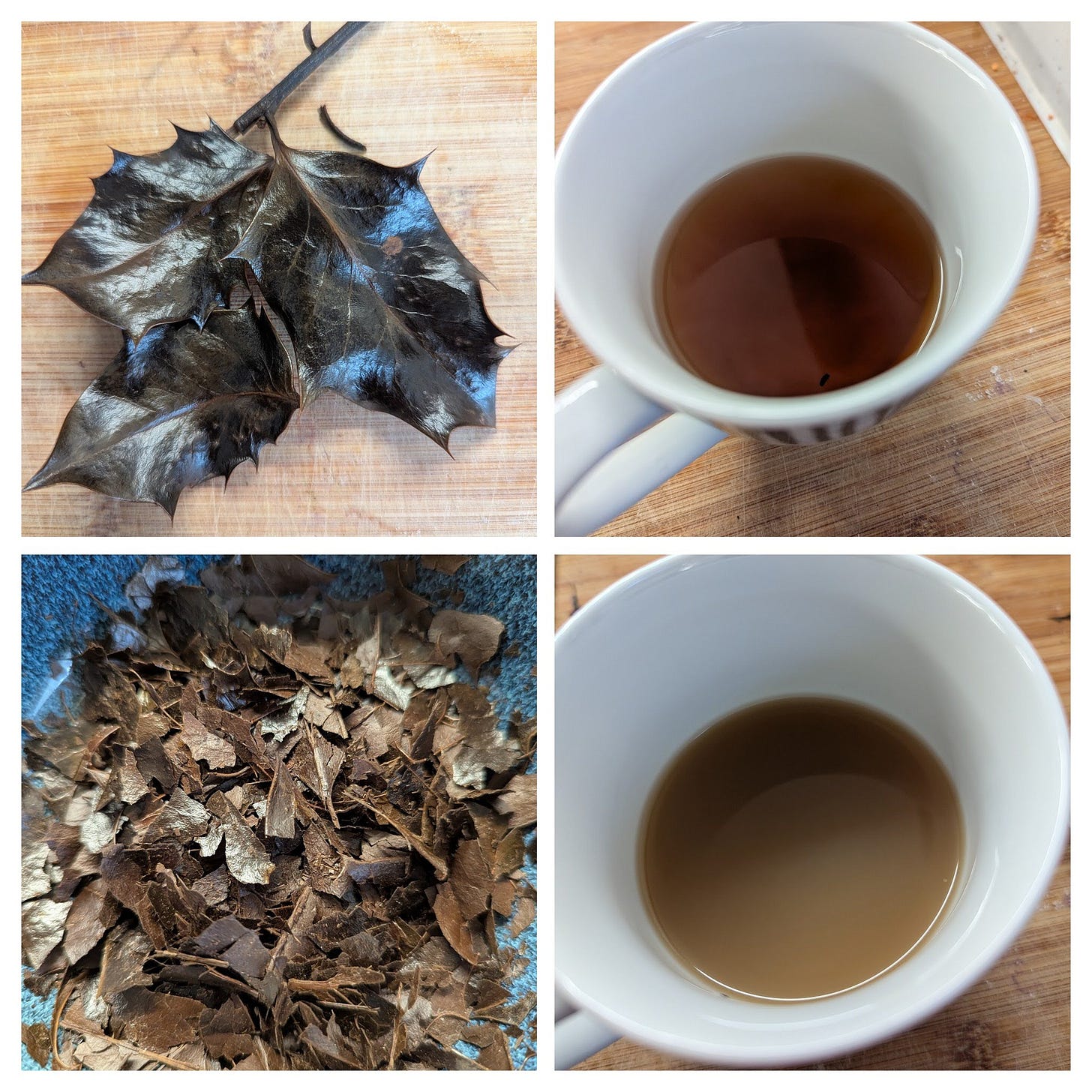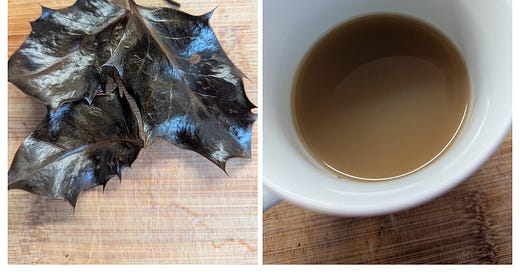Please do your own research, I’m not responsible for what you consume.
In a previous post, I delved into the evidence of consuming English Holly (Ilex aquifolium) as a hot beverage.
Holly
In the grim half-light of the British winter, my hungry stare turns from Common Ivy to English Holly, Ilex aquifolium.
Feel free to catch up on that, but this article can mostly stand by itself.
Sometimes I consider myself scientific (or at least science-adjacent), but in the case of making my first cup of I. aquifolium tea I was impatient.
Experiment 1: “Just roast it”
I plucked a branch of holly from a local foot path, washed the leaves and roasted them at 150°C (300°F) in my air fryer for several hours until they were very crispy and brown. I crushed the leaves into a semi-fine powder.
My observations are thus:
A strong fishy smell permeated the leaves all through the roasting process
One tea spoon of the holly leaf powder in half a cup of boiling water, steeped for minutes, made a fishy smelling brown liquid that when tasted gave a fishy taste that clung to my palette.
Half a tea spoon in half a cup of boiling water, with just a few seconds of steeping, had a similar effect.
After drinking a quarter of the liquid, I didn’t experience any digestive effects the day after, or several weeks after
In fact, I had to brush my teeth and tongue to remove this fishy taste.
Not a good start. A mysterious nasty lingering “fishy” smell and taste all around, but I’m nothing if not persistent (or just stubborn).
Experiment 2: “Quick cure and roast”
After my fishy failure of experiment 1, I talked to quite a few people on how other Ilex species are prepared into a beverage and the main take-home message is to cure the holly leaves first. When I say cure, that is quite a nebulous term and I’ve taken it to mean that we should air dry the leaves for some unspecified amount of time.
In this experiment, I used some more leaves from the same holly branch as experiment 1 and “cooked” them at 60°C (140°F) in my air fryer for 2 hours - this is what I’m calling a “quick cure” - a bit above normal air temperature. After the quick cure, I air fried the leaves as in experiment 1. Before I crushed the leaves to powder, I roughly chopped off the spiky bits.
Here are my observations:
The quick cure phase was interesting:
A very aromatic floral scent was released in the first few minutes, which then dropped off
A strong fishy smell was subsequently released which then slowly dropped off
The high temperature air fry didn’t throw any extra fishy scent into the air
The subsequent 5 minute soak with one teaspoon of leaf powder hot water yielded a light brown liquid that had a very tiny taste of fish. At these dilutions, it was more of an umami undertone
Adding milk to another batch made a very pleasant black tea (Camelia sinensis) lookalike.
Interesting stuff! Both with and without milk, the tea was very drinkable - in fact, I struggled not to quaff the whole thing. It’s important to me that I don’t hurt my animal test subject (me!).
Experiment 3 - “Long cure and long high roast”
My last experiment involves curing the leaves for 4 hours at 50°C (120°F), followed by 2 hours at 190°C. New observations are as follows:
There is, as William Forsyth puts it, “a very disagreeable smell” at this higher temperature
It’s important to remove the prickles before pounding the roasted leaves or you won’t get a uniform tea blend.
Gathering Thoughts
I’m sat here, next to a steaming mug of Ilex aquifolium tea (with milk). Of the three experiments, number 3 is best with milk, number 2 is best without milk (more aromatic) and number 1 should be avoided.
My conclusions are that the curing phase at the beginning is important to remove the fishy (maybe even rancid) smell and taste that would develop if the fresh leaves were just roasted.
What could be responsible for this smell and taste? At this point, I asked a large language model to chew on some research that listed the chemical constituents of Ilex aquifolium and it thinks that the fatty acids in the leaves are mostly evaporated away on the curing step. If this step is missed, it hypotheses(!) that an excess amount of oxidised fatty acid byproducts is “baked” into the structure of the leaf. It is these by products that in high amounts lead to a fishy smell.
And this all seems logically consistent. Apologies if you are opposed to large language models, but in this case - for someone who is just a keen amateur - it helps me peek under the covers. I do try and fact check my assistant though.
Just to reiterate, the LLM thinks that curing the leaves evaporates a large amount of any fatty acids. Without the curing step, during the high temperature roasting step, the fatty acid oxidised byproducts get baked into the structure of the leaf - hence, fishy smelling and tasting brew. With the curing step, most of the fatty acids are evaporated away and we just end up with an aromatic brew.
I’m trying to think of the right phrase to describe this Common Holly tea. Perhaps something like “aromatically scented with slight umami undertones”. I was once gifted some Chinese tea (C. sinensis) leaves (jasmine tea, or something similar) that had somehow been prepared with some kind of fragrant oil - you could see the slight layer of oil at the surface of the beverage - and Holly tea reminds me of this brew. Some Chinese people also pour some black Chinese tea into their rice bowls after finishing a meal - the combination of fragrant beverage with the oils of the meal also strongly remind me of Holly tea.
When milk is added, the beverage is smoother as expected; the aromatic and umami tones are blunted but still present.
Is Holly tea safe to drink? I don’t know. People have been addicted to C. sinensis beverages long before modern science. Perhaps it is toxic if consumed daily but just fine occasionally. I don’t have the skills or equipment to answer this question - all I have is myself as a human lab rat and the dubious hypotheses of a large language model. What I will say is that quite a few other Ilex species are consumed in vast quantities and the chemical analyses of these species are very similar (barring caffiene) to I. aquifolium.
As I sip at this steaming mug of holly tea, my thoughts turn to William Forsyth in the 1850s, preparing the same holly tea for children and adult. They turn to these mysterious German Black Forest inhabits who might also have drunk holly tea, and further back to those peoples who first tried to brew other Ilex species and found them delicious.
The feeling of rediscovery, of linking back to people long gone, has been very special.
Pour out some holly tea to our forebears.
Common Holly Tea recipe
Again, please do your own research, I’m not responsible for what you consume.
Gather some holly branches
Optional: trim off the prickly bits
Dehydrate the whole branches of holly at 50°C (120°F) for 4 hours
Roast the whole branches of holly at 190°C (375°F) for 2 hours
Remove the leaves from the branch and pound/grind with a pestle and mortar or similar until the leaves break down into a rough tea blend
Use a metal tea strainer, AeroPress-type device or something similar and brew your roasted holly leaves for 5 minutes, roughly 6 tea spoons per normal mug (250-350ml)
Enjoy with or without milk

Final Thoughts
At least one text indicates that fresh holly leaves can just be boiled like a kind of soup to make a tea-like brew. This seems like low hanging fruit if true.
If you try making your own holly tea, please let me know what you think! I’d love to find out other people’s experiences.
What do you think about the LLM’s hypothesis on the origin of the fishy smell? In some ways it doesn’t matter, I’ve found a method of removing it (curing) but it’s nice to know the origin story.
Here is an updated list of caffienated Ilex species (thanks to readers): I. vomitoria, I. cassine, I. paraguarienesis, I. tarapotina
I’ve read that Ilex glabra was consumed by the first peoples of Eastern North(?) America - it makes a minty and aromatic cooling beverage. Ilex opaca has also been made into a tea. When you open the can of worms, there are a surprising number of Ilex species beverages! I should probably make a post about all the Ilex drinks I’ve come across on my research.
Further Reading
Biological Potential and Chemical Profile of European Varieties of Ilex
GC-MS and PCA Analysis of Fatty Acid Profile in Various Ilex Species
“We have demonstrated, that Ilex sp. cultivars can be divided into four groups based on their fatty acids profile. Majority of the variation is caused by hexadecanoic, α-linolenic and linoleic acids”
“n-Hexadecanoic acid was identified to provide ‘rancid’ and ‘pungent’ odors, which was the most frequently detected acid compound in Fu-brick tea”
“Dried and roasted inkberry leaves were first used by Native Americans to brew a black tea-like drink, hence the sometimes used common name of Appalachian tea for this shrub.”
“If I drink Gallberry tea within 40 minutes I have to go pray to the porcelain god.”





Yaupon (Ilex vomitoria) was a common tea in the US. Yerba mate is also an ilex species.
https://www.southernfoodways.org/southern-sip-yaupon-holly/
Thanks for being willing to experiment on yourself for us! I’d love to see if anything comes of you potentially crossing the various caffeinated species